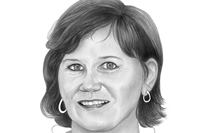Is a lack of risk and experimentation keeping the high-performance building industry from reaping big rewards?
Over the past three years, Hanley Wood has consulted building and architecture experts under its Vision 2020 program to discuss the role of sustainability in the future of the design and construction industry between now and 2020. The consensus is that we must change the way we design, construct, and operate our buildings, and we must do it now. So what does this mean?
I recently chatted with Hanley Wood Sustainability Council members Blaine Brownell, AIA, the Vision 2020 Materials + Product section leader and associate professor at the University of Minnesota School of Architecture, and Dennis Wedlick, AIA, founder and co-owner of BarlisWedlick Architects and the Vision 2020 Building Design + Performance section co-leader, about the relationship between product development and building design and performance, and how the intersection between the two realms—products and architecture—could drive the path ahead.
When it comes to advancing sustainability, there can be an interesting push-pull dynamic between the materials and products realm and the design and performance realm. Are there opportunities for product development to drive architectural expression and performance, and vice versa?
Blaine Brownell: I’m very interested in the intersection between emergent applications or innovations in application—thinking about material expressions and how we advance the discipline of architecture. Is it purely technology driven? I don’t think so, because architecture is also a cultural, social, and artistic enterprise. What does this all mean for sustainable design?
Design, as we generally think of it, has been diminished in this field to the overwhelmingly technological task of trying to understand life-cycle assessments, energy modeling, green checklists, and new protocols and codes. All of that is very important, but in my classes I’ve seen graduate-level students get so bogged down in running DIVA, IES, or Athena Impact software that the design gets short-changed. It’s important that they learn to use these tools, but it’s also important that they understand the broader principles behind them. We’re increasingly seeing design become more determined by black box processes that happen within plug-ins, software engines, or prescriptive-based checklists. In my perspective, we’re seeing a creative exploration diminish.
Dennis Wedlick: Many of us in the design profession are struggling with the same issues. We did our first Passive House project soon after the economic crash. We thought we could market the idea, attract a developer, and maybe get some grant money for the building science piece. We printed 10,000 copies of a newspaper talking about the project and the tagline was “It’s the architecture, not the technology.”
The challenge is that people will always push back, and say, “How can you say it’s not the technology? The technology is in the materials. The technology is in the building science. The technology is in the thermal modeling.” But our point [in using the tagline] was that while those things are used as tools, what’s really conserving energy is the building’s design.
Brownell: Something that has increasingly come up in my teaching is the relationship between material intensity and the energy intensity of producing materials and operating buildings. Let’s say you want to thicken the façade to make the building as insulated as possible. You could add more material—a lot of which comes from petroleum-based sources—or you could step back to consider how much the building weighs, which may lead you to the seek out superlight material intensity. Are there ways that we could potentially reduce material intensity while maximizing energy performance?
Wedlick: As an industry, if we say we want to conserve as much energy as possible and use the least materials possible to do so, it sends a clear message to manufacturers, researchers, and developers.
A Passive House doesn’t require petroleum-based products. We use them in some cases where they are the thinnest and most-affordable way to achieve the climate isolation we need for a building to perform. But building product manufacturers are also interested in producing SIPs without petroleum or foundation insulation that is an inch thick rather than 14 inches thick. As designers, our job is to be clear about what we need. We need to teach the next generation that it is not about saying “I want a net-zero building, so sell me a bunch of solar panels so that I can have the design I want.” We can say the walls are still too thick, this building is still too heavy, and has too much petroleum.
We have a building industry and a building material industry that wants to get back in the game and lead. We have the technology and the design skills to partner with them.
When you say architects and builders should be clear about what they need, what kind of details are helpful?
Wedlick: Thermally isolating the inside of the building is the way to go, and we need windows, doors, and wall materials that do that. However, we don’t have easy access to these materials. The clarification that is needed is that we want to thermally isolate our interior.
Brownell: There are interesting questions that can lead to other requests for product and material manufacturers. One of those would be the desire to maximize the interior footprint of a building whose envelope is against the property line while minimizing the thickness of the exterior wall. This suggests looking at technologies such as vacuum-insulated panel technology or phase-change material. Those are interesting frontiers to think about.
And what about access to light? Wherever we have windows, we have thermal holes. We have new glazing technologies that begin to defy that principal, but a lot of these materials are expensive and fairly new. However, using aerogel-filled panels or different micro-encapsulated insulating materials suggests that it’s possible to have light-infused spaces. Can the building envelope provide light without compromising energy conservation? Architects could initiate this demand from manufacturers.
Let’s talk about this push-pull between the design community and manufacturers. Who drives the conversation?
Wedlick: The key player is The National Association of Homebuilders. They have incredible testing facilities and the ears of all the manufacturers. They’re the ones that could help us explain where we are as a design industry with thermal envelopes.
If we need risk and experimentation in product development and design, how do you weigh the amount of risk you’re willing to take?
Brownell: I recently taught an intensive, one-week studio about smart materials with a couple of invited instructors, Martina Decker and Peter Yeadon. They work with a lot of interesting elements such as dielectric elastomers and have created a homeostatic façade system. We talked about how a lot of experimental work currently resides in the prototype model, temporary pavilion, or installation, but doesn’t occur within traditional buildings. It’s a challenge. World expos, the Olympics, and the Solar Decathlon tend to be very conducive arenas for innovation, but the frustration is that they are temporary and use a lot of materials. You end up with a prototype house that may last six years or six months that has the material intensity that you’d expect for a house that will last 60 years. It’s a huge investment in labor and materials. Why aren’t we looking for ways to do more experimenting in permanent practice or more enduring programs? I think we can all agree that we want that type of advancement to occur on a broader scale with the buildings in which we live and work, rather than just with one-off, temporary pavilions.
What do you think is standing in the way of a transition to more broad-scale application?
Brownell: There’s a pervasive intolerance to risk in the industry, and you can understand that because occupant health and welfare is a serious thing. On the other hand, sustainability has really influenced the industry to make changes, so there are potential incentives there, whether it’s the branded aspect of LEED or the Living Building Challenge or the long-range economic incentives of an energy-conserving building.
There’s a movement afoot with the Safety Act, in which the Department of Homeland Security is promoting material experimentation to develop and deploy more advanced materials. It’s interesting that our government is even stepping in to promote material innovation at the building scale by trying to mitigate the risk. That kind of development could lead to some change.
Wedlick: There are people that have taken risks and they’ve paid off. There’s a lot of building materials that are healthier to be around, we have reduced the amount of energy we consume with our buildings, and our codes are tougher than ever. There are certain things that are always going to be a challenge. The developer that is only after the bottom line is not going to necessarily want to take a risk, but there are many developers that want to make a name for themselves, take risks, and produce some amazing results.
There’s an interesting opportunity in the residential world with Habitat for Humanity. There’s been a sea change in how the group works and they’re taking risks. They are not just interested in bottom-line construction—they’re interested in high-quality architecture. Actually, a lot of the Solar Decathlon prototypes were picked up by Habitat for Humanity and we’re doing Passive House homes for them. The industry has to identify the real players and work hard to create ideas that have purpose.
Some things are just big ships trying to move. The mechanical industry is an enormous ship that is loaded down with regulations and rules, and it’s hard to move. Residential design used to be more respected and we’ve lost a lot of risk takers. I’m lucky to be in the custom home business because I can attract clients that want to take risks.
Stay tuned for future conversations between the 2014 Hanley Wood Sustainability Council participating in our Vision 2020 program. Scroll over points in our on-going timeline to learn more about the path ahead in green building. Track our progress all year as the Hanley Wood Sustainability Council shares its perspectives on initiating, tracking, and ensuring progress toward these sustainable priorities and goals. This year's program will culminate in an exclusive Vision 2020 Sustainability Summit in conjunction with Greenbuild International Conference and Expo in New Orleans, and with a special Fall edition of ECOBUILDING REVIEW.















